Background
Sancta Susanna examines the relationship between celibacy and lust in Christianity, depicting the descent of a nunnery into sexual frenzy. Hindemith, around this time in his career has often been regarded, ‘a twenty-four-year-old dabbling in the realm of German expressionism’, and although it cannot be described as a fully fledged work of expressionism, the opera undoubtedly shows a significant reflexivity on the composer’s part to such contemporary artistic trends.
Much like his contemporaries, Hindemith spoke of the early twentieth century as a time in which ‘the old world exploded’, and artists were forced to make sense of this changed world by disregarding to a large extent, codes and conventions that had been established - in some cases - for centuries. Thus in the libretto (from the notable expressionist poet and playwright August Stramm) stage directions dominate over speech, which is highly fragmented through ellipses and incomplete phrases. Central to the opera is the expressionistic notion of shock as a means of articulating oneself, and musically, this was achieved to a large extent by pushing harmonic and tonal processes ‘to the very limits of tonality’. Hindemith did not however, divorce himself entirely from formalism, and the work is structured in a series of variations.
Critical reaction
The controversy generated by the opera upon its premiere is reflected in the difficulty Hindemith faced, getting the work performed in the first place. Among his problems was finding a competent and willing conductor. Fritz Busch, who had premiered the composer’s earlier operas, and who was seen as both progressive, and a champion of Hindemith’s work, refused to offer his services on moral grounds. Upon its premiere, contemporary critic, Karl Grunsky wrote that the performance ‘signifies a desecration of our cultural institutions’, and at a performance in Hamburg, concert goers were required to pledge in writing not to cause a disturbance during the performance. Even as recently as 2007, performances of the work have attracted criticism from Christian organisations.
At the same time as it has generated controversy, Sancta Susanna (and more generally Hindemith's operatic triptych) has been praised for its technical excellence. In 1930, Marion Scott wrote in Proceedings of the Musical Association that although the contents of his early operas are unquestionably ‘horrific’, their ‘musical brilliance is equally certain, and “Sancta Susanna” is the cleverest of the bunch.’ The article describes him as ‘the acknowledged leader of the “new music”’, and it is in no small part that his provocative early works contributed to such recognition.
Synopsis
The opera opens in a convent at night, the protagonist, Susanna, lying in prayer in front of an altar. She is approached by a number of figures, the most prominent of whom is Sister Clementia, who states that Susanna is sick, and ‘scarcely live[s] on this earth any longer’. The dialogue is underpinned by a high pedal in the organ, and - in conjunction with conventionally extra-musical sounds such as that of belfry bells, - heightens one's sense of total immersion, and helps reinforce the ritualistic and religious themes.
Susanna finds herself increasingly seduced and overpowered, initially by the sweet scents and sounds entering through the chapel window, but soon by the physical presence of her maid-servant, and her lover. Following a Latin invocation of Satan by Susanna, she is cautioned by Sister Clementia, with the tale of a nun, Sister Beata, who gave in to her erotic fantasies, and as a punishment was bricked up behind the altar. Susanna, no longer capable of abstaining, discards her veil, rips the loin cloth from the crucifix in front of her, and demands such punishment from the nuns, who have now congregated around her. Musically, this finale consists of a giddying sequence in woodwind and strings, abruptly cut off by a piercingly dissonant, yet dynamically restrained chord in the upper strings. Following this, vocal and brass forces compete – the nuns all now chanting ‘Satana’ - in what is both a deafening and densely scored series of chordal exchanges.
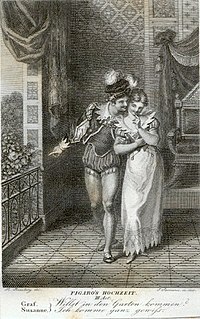
The Marriage of Figaro, K. 492, is an opera buffa in four acts composed in 1786 by Wolfgang Amadeus Mozart, with an Italian libretto written by Lorenzo Da Ponte. It premiered at the Burgtheater in Vienna on 1 May 1786. The opera's libretto is based on a stage comedy by Pierre Beaumarchais, La folle journée, ou le Mariage de Figaro, which was first performed in 1784. It tells how the servants Figaro and Susanna succeed in getting married, foiling the efforts of their philandering employer Count Almaviva to seduce Susanna and teaching him a lesson in fidelity.

Paul Hindemith was a prolific German composer, violist, violinist, teacher and conductor. In the 1920s, he became a major advocate of the Neue Sachlichkeit style of music. Notable compositions include his song cycle Das Marienleben (1923), Der Schwanendreher for viola and orchestra (1935), and the opera Mathis der Maler (1938). Hindemith's most popular work, both on record and in the concert hall, is likely the Symphonic Metamorphosis of Themes by Carl Maria von Weber, written in 1943.

Samson and Delilah, Op. 47, is a grand opera in three acts and four scenes by Camille Saint-Saëns to a French libretto by Ferdinand Lemaire. It was first performed in Weimar at the Grossherzogliches Theater on 2 December 1877 in a German translation.
Alceste, Wq. 37, is an opera by Christoph Willibald Gluck from 1767. The libretto was written by Ranieri de' Calzabigi and based on the play Alcestis by Euripides. The premiere took place on 26 December 1767 at the Burgtheater in Vienna.

Elektra, Op. 58, is a one-act opera by Richard Strauss, to a German-language libretto by Hugo von Hofmannsthal, which he adapted from his 1903 drama Elektra. The opera was the first of many collaborations between Strauss and Hofmannsthal. It was first performed at the Königliches Opernhaus on 25 January 1909. It was dedicated to his friends Natalie and Willy Levin.
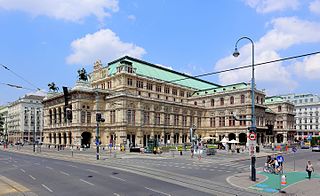
Opera in German is that of the German-speaking countries, which include Germany, Austria, and the historic German states that pre-date those countries.

Salome, Op. 54, is an opera in one act by Richard Strauss. The libretto is Hedwig Lachmann's German translation of the 1891 French play Salomé by Oscar Wilde, edited by the composer. Strauss dedicated the opera to his friend Sir Edgar Speyer.

The term expressionism "was probably first applied to music in 1918, especially to Schoenberg", because like the painter Wassily Kandinsky (1866–1944) he avoided "traditional forms of beauty" to convey powerful feelings in his music. Theodor Adorno interprets the expressionist movement in music as seeking to "eliminate all of traditional music's conventional elements, everything formulaically rigid". This he sees as analogous "to the literary ideal of the 'scream' ". As well Adorno sees expressionist music, as seeking "the truthfulness of subjective feeling without illusions, disguises or euphemisms". Adorno also describes it as concerned with the unconscious, and states that "the depiction of fear lies at the centre" of expressionist music, with dissonance predominating, so that the "harmonious, affirmative element of art is banished".
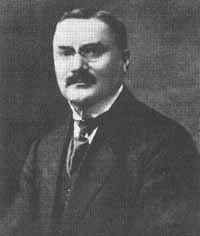
August Stramm was a German war poet and playwright who is considered the first of the expressionists. Stramm's radically experimental verse and his major influence on all subsequent German poetry has caused him to be compared to Ezra Pound, Guillaume Apollinaire, James Joyce, and T.S. Eliot. A reserve officer in the Imperial German Army, Stramm was called up to active service at the outbreak of World War I and was killed in action on the Eastern Front.
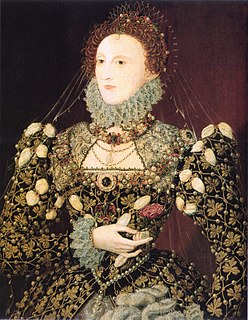
Kenilworth, A Masque of the Days of Queen Elizabeth, is a cantata with music by Arthur Sullivan and words by Henry Fothergill Chorley that premiered at the Birmingham Festival on 8 September 1864.

Cardillac, Op. 39, is an opera by Paul Hindemith in three acts and four scenes. Ferdinand Lion wrote the libretto based on characters from the short story Das Fräulein von Scuderi by E. T. A. Hoffmann.

Die Teufel von Loudun is an opera in three acts written in 1968 and 1969 by Polish composer Krzysztof Penderecki, and then revised in 1972 and 1975. It has a German libretto by the composer, based on John Whiting's dramatization of Aldous Huxley's book of the same name.

Der Zar lässt sich photographieren is an opera buffa in one act by Kurt Weill, op. 21. The German libretto was written by Georg Kaiser, and Weill composed the music in 1927. It is a Zeitoper, a genre of music theatre which used contemporary settings and characters, satiric plots which often include technology and machinery. Musically the Zeitoper genre tends to be eclectic and borrow from Jazz. The genre has practically disappeared from the world's opera houses. Historically the Zeitoper came to an abrupt end with the Nazi period, and after the war the cultural institutions were perhaps hesitant to return to the lighter, often decadent and comic operas written before the holocaust changed the artistic perspective. This conjecture is supported by the statistical fact that of all of Weill's, Schönberg's, Hindemith's and Krenek's works - it is these very shorter, satirical Zeitoper works that are no longer performed.

Das Nusch-Nuschi, Op. 20, is an opera in one act by Paul Hindemith, with a German libretto by Franz Blei.

Mörder, Hoffnung der Frauen is an opera in one act by Paul Hindemith, written in 1919 on a German libretto by Oskar Kokoschka which he based on his play of 1907. The opera was the first in a triptych of expressionist one-act operas, the others being Das Nusch-Nuschi, and Sancta Susanna. They were the first operas written by Hindemith. The first two were premiered together in Stuttgart on 4 June 1921, all three were performed at the Oper Frankfurt in 1922.
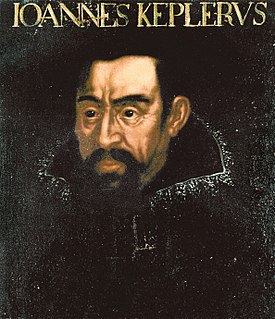
Die Harmonie der Welt is an opera in five acts by Paul Hindemith. The German libretto was by the composer.
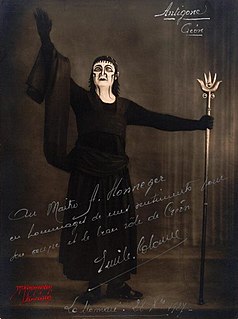
Antigone is an opera in three acts by Arthur Honegger to a French libretto by Jean Cocteau based on the tragedy Antigone by Sophocles. Honegger composed the opera between 1924 and 1927. It premiered on 28 December 1927 at the Théâtre Royal de la Monnaie with sets designed by Pablo Picasso and costumes by Coco Chanel.

The Legend is a one-act tragic opera composed by Joseph Carl Breil to an English libretto by Jacques Byrne. It premiered at the Metropolitan Opera in New York City on March 12, 1919 in a triple bill with two other one-act operas, John Hugo's The Temple Dancer and Charles Cadman's Shanewis. Its melodramatic story is set in Muscovadia, a mythical country in the Balkans, and involves an impoverished nobleman turned bandit, his daughter Carmelita, and her lover Stephen, a captain in the hussars. The action unfolds over a single night at the end of which both lovers are dead—Stephen stabbed to death by Carmelita and Carmelita shot by Stephen's fellow hussars. The only one of Breil's six operas to be performed by a major opera company, The Legend received scathing press reviews and after its three performances at the Met disappeared from the repertory.
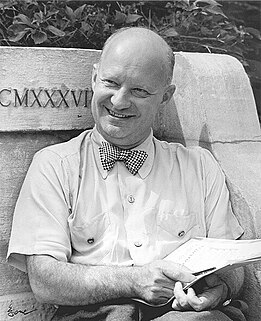
Die Harmonie der Welt Symphony, IPH 50, is a symphony by German composer Paul Hindemith composed in 1951, which served as the basis for his opera Die Harmonie der Welt.
















